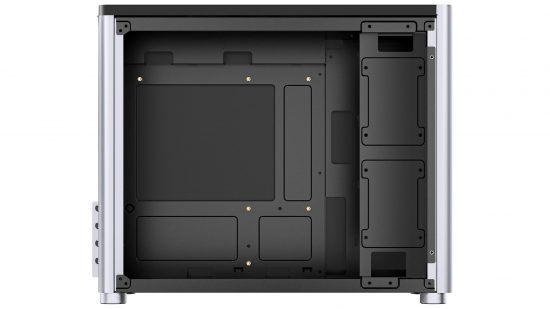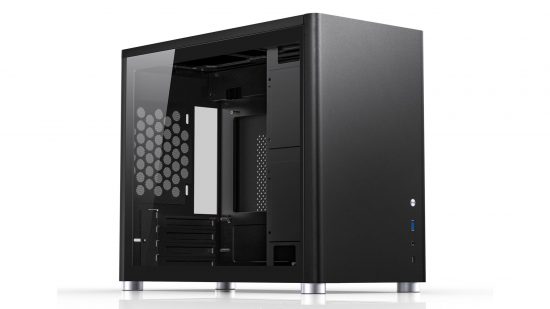Our Verdict
81%Great air and water-cooling potential in an attractive chassis, but it’s a bit basic.
It’s been a while since we’ve looked at a micro-ATX case, and the Jonsbo D30 is quite different from your usual off-the-shelf chassis. For starters, it doesn’t have any fans as standard, while cases such as Kolink’s Citadel Mesh RGB come fully equipped with fans.
The latter also uses a traditional front-to-back airflow system and typical plastic and steel construction. The Jonsbo D30, on the other hand, has the majority of its fan mounts in the roof and base. It also lacks any fan mounts in the front section and sports largely aluminum construction with a smattering of glass and steel. This means it weighs just 5kg, and it’s reasonably compact too, measuring just 24cm wide and 33cm tall, although its length of 40cm gives it a hefty footprint.
A lot of that volume is a result of the case offering plenty of room for large components, with 168mm of CPU cooler clearance, and it also supports ATX PSUs. Due to the way the D30’s PSU mount is positioned, with the PSU mounted down vertically at the front with the use of an angled kettle lead, if you use a 170mm or shorter PSU, there’s up to 355mm of graphics card clearance too – this figure reduces to 305mm if you use a longer PSU.
Immediately we can see the benefits of using an SFX PSU in this chassis design. Doing so would have shaved inches off the case’s depth and width, and even mounting it on its side would have made it no longer, but could have reduced the width a little. Still, with monstrous graphics cards all the rage at the moment, a little extra space is welcome and there’s plenty of space even for a massive RTX 4090 card in here, which will benefit from the large vented area below it too.
While there are no fans as standard, there are plenty of options here, with two 120/140mm mounts in the roof and the same in the base, along with a single 120mm fan mount in the rear. Jonsbo says the radiator limit in the roof and base is 240mm, but if you use slim 280mm radiators from Alphacool, and slim 140mm fans, you can fit larger radiators in both locations and still have enough clearance for a dual-slot graphics card.

Despite its elegant exterior and use of premium materials, the D30 does lack a bit of finesse when it comes to building a PC into it. You have to remove four screws in order to release the lid and remove the side panel, and it would have been easy for Jonsbo to add a pop-off or magnetic hinged panel here. The base and roof panels, which are home to the fan mounts, would make for perfect removable trays to make installing fans and radiators easier as well, but these are riveted in place instead.
Also, while the rear vent holes might look pleasant, large circular holes are very inefficient compared with hexagonal holes, and we suspect the vents here are circular because they’re cheaper to create. Jonsbo has also cut costs with the front Type-C port, which is limited to USB 3 speeds and doesn’t use a proper Type-C header. Thankfully, the rest of the case is fantastic, with excellent build quality, dust filters and an eye-catching design, with minimal fuss on the front panel.
Storage options are basic, with a single 3.5″ hard disk mount that’s shared with a 2.5in mount, plus three further 2.5″ mounts. There are four expansion slots, so using triple-slot graphics cards won’t be an issue either. Our last complaint, though, is limited cable stowage. There’s zero clearance behind the far side panel, unless you’re only routing extremely thin cables, and there are only small compartments at the front of the case to make up for it. You’ll definitely want to keep your wiring simple.
Jonsbo D30 cooling performance
With no fans included as standard, we added some of our own with one for testing – we installed one in the base below the graphics card, and another in the rear of the case to aid our CPU cooler. This resulted in a CPU delta T of 47°C, which was a touch warmer than the result from the Kolink Citadel Mesh RGB with its multiple fans and vented front panel. The GPU delta T was better, though, undercutting the Citadel Mesh RGB by 2°C thanks to the option to point fans straight at the GPU cooler.
| Jonsbo D30 temperature results | |
| CPU Delta T | |
| Kolink Citadel Mesh RGB | 46°C |
| Antec DF700 Flux | 47°C |
| Cooler Master MasterBox 500 | 47°C |
| NZXT H510 Flow | 47°C |
| Jonsbo D30 | 47°C |
| Corsair 5000D Airflow | 48°C |
| Fractal Design Meshify 2 Compact | 50°C |
| GPU Delta T | |
| Jonsbo D30 | 41°C |
| Corsair 5000D Airflow | 41°C |
| Fractal Design Meshify 2 Compact | 41°C |
| Cooler Master MasterBox 500 | 42°C |
| NZXT H510 Flow | 42°C |
| Kolink Citadel Mesh RGB | 43°C |
| Antec DF700 Flux | 43°C |
We’d be inclined to add another fan to the base of the case before moving on to the roof, but it’s clear the case would be quite at home with AIO liquid coolers, while also leaving you the option to install a custom water-cooling loop with a short graphics card and small reservoir. The closed front section helps to keep noise leakage to a minimum too, although some noise does escape through the roof.
Jonsbo D30 pros and cons
Pros
- Good cooling
- Great air and water-cooling support
- Elegant design
Cons
- Basic accessories and features
- No USB 3.2 Gen 2 Type-C support
- Limited cable stowage
Jonsbo D30 specs
The Jonsbo D30 specs list is:
| Dimensions (mm) | 290 x 466 x 495 (W x D x H) |
| Material | Steel, glass |
| CPU cooler clearance | 165mm |
| Max graphics card length | 435mm |
| Weight | 12.1kg |
| Front panel | Power, 1 x USB-C 3.2 Gen 2, 2 x USB 3, stereo |
| Drive bays | 2 x 3.5″ / 2.5″, 4 x 2.5″ |
| Form factors | ATX, micro-ATX |
| Available colors | Black, white |
| Cooling | 3 x 120mm side fan mounts (3 x 120mm fans included), 3 x 120mm/2 x 140mm base fan mounts (fans not included), 3 x 120mm/2 x 140mm roof fan mounts (fans not included), 1 x 120mm rear fan mounts (120mm fan included) |
Jonsbo D30 price
Price: Expect to pay $429 US / £423 GBP for 32GB (2 x 16GB), 4800MHz
Jonsbo D30 review conclusion
As a blank canvas, the Jonsbo D30 has a lot to offer both air and water-cooled systems, with plenty of space for fans, large coolers, beefy graphics cards and well-placed radiator mounts. It’s particularly suited to housing large graphics cards and can easily accommodate monsters such as Nvidia’s new GeForce RTX 4090 Founders Edition. The case looks fantastic too, and despite a lack of finesse in the build process, working with the D30 is relatively easy.
For £95, the D30’s shortcomings can mostly be forgiven, especially with the materials used, but a couple of issues left a sour taste in our mouths, even at this price. The lack of a full-fat USB Type-C port on the front panel was disappointing, and it would be so easy for Jonsbo to make the side panels tool-free, and add removable top and bottom fan mounts too. These are standard features on many similarly priced cases now, which leaves the Jonsbo D30 feeling like it’s all style and little substance.
However, it’s not overly expensive, it has great hardware and cooling support and it’s otherwise a solid home for a high-end air or liquid-cooled micro-ATX PC. Just make sure you kit it out with some fans and be prepared to spend a little extra time tidying those cables. If this isn’t the case for you, maybe check out our best PC case guide for some more ideas.
